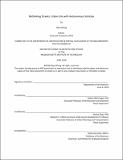Rethinking streets : urban life with autonomous vehicles
Author(s)
Zhang, Daya, S.M. Massachusetts Institute of Technology
DownloadFull printable version (36.20Mb)
Alternative title
Urban life with autonomous vehicles
Other Contributors
Massachusetts Institute of Technology. Department of Architecture.
Advisor
Rafael (Rafi) Segal and Jinhua Zhao.
Terms of use
Metadata
Show full item recordAbstract
Historically, streets have served a range of functions, primarily those associated with traffic circulation and social interaction. However, in the 20th century, the street design became centered on traffic movement and maximum space for automobiles, while public lives were marginalized to narrow sidewalks. Contemporary urban planners and designers have acknowledged that both livability and efficiency are indispensable components to a city's sustainable development. However, to achieve them both is a difficult task with the conventional dominance of automobiles. This thesis explores the mutual influence of urban design and transport technology, and offers a solution to rethink streets as urban surfaces, which integrate traffic infrastructure and the public realm with the application of shared autonomous vehicles. The thesis presents a new design paradigm based on a three-prong approach: 1) design of shared surfaces for pedestrians, cyclists and vehicles as a continuous public living room; and (2) inclusion of efficient surfaces that provide dedicated space for shared vehicles and cyclists to collect and distribute people at a faster speed; and (3) inclusion of the transition zone between shared surfaces and efficient surfaces. Another feature of this thesis is a new approach to the design of these autonomous vehicles that combines the self-driving technology of autonomous vehicles with new robotic features that tell vehicles when to reduce speed to share surfaces with pedestrians, and when to resume speed on dedicated surfaces. Using South Boston Waterfront as a case study, the thesis shows that cities do not have to remain under the dominance of vehicles; and that urban life can gain new spatial integrity that serves the needs of people and, at the same time, responds to the realities of urban mobility.
Description
Thesis: S.M., Massachusetts Institute of Technology, Department of Architecture, 2018. This electronic version was submitted by the student author. The certified thesis is available in the Institute Archives and Special Collections. Cataloged from student-submitted PDF version of thesis. Includes bibliographical references (pages 92-93).
Date issued
2018Department
Massachusetts Institute of Technology. Department of ArchitecturePublisher
Massachusetts Institute of Technology
Keywords
Architecture.